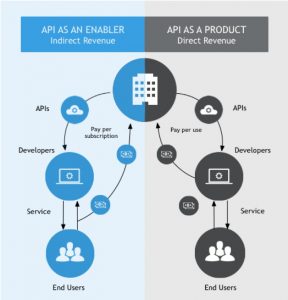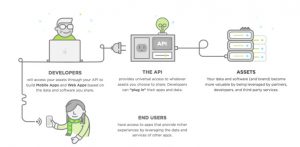Application programming interfaces (APIs) are more than just a technical construct or a development technique in today’s world. They are considered to be a powerful force, having the ability to mold an organization’s business model, with the promise of providing new revenue streams for it.
Technically an API is
![]() An interface to a software component that can be invoked at a distance over a communications network using standards based technologies (Source: Winning in the API Economy).
An interface to a software component that can be invoked at a distance over a communications network using standards based technologies (Source: Winning in the API Economy).
Simply put, APIs expose something useful that can be used by a third party to build a service of its own over it. Such a service could be a mobile application that helps you book a hotel room; a website that lets you download a software or an SMS facility that keeps you updated about the status of the pizza that you just ordered. APIs make it easier for different technology platforms and applications to interact with each other in a commonly understood language.
For companies like Salesforce, Expedia and eBay, APIs play a significant role in earning more than 50% of their hard-earned revenues. Such businesses are leveraging their resources by allowing developers to access them by exposing APIs and charging a fee. This fee could be charged for letting developers access these APIs, in which case they are positioned as a product and the users “pay per use”. On the other hand, a “revenue sharing model” could be used in which developers are charged depending upon the subscription of the service that they build upon those APIs (Source: APIs: A bridge between mobile operators and start-ups in emerging markets).

Such a business model proves to be successful because it yields benefits for each party involved. Companies exposing APIs are able to earn a direct or indirect fee for allowing use of their assets. On the other hand, developers are able to capitalize on the resources already created by another party, without the need to create them from scratch. This spurs creativity and innovation at their end as they are able to combine a number of APIs from different sources and create a new service. Such a strategy of building services proves to be faster and more efficient as compared to the strategy of everything in-house, because of the huge amount of time and financial resources the latter requires (Source: The Business of APIs: What Product Managers Need to Plan For). All of this paves way for an enhanced user experience for end users who benefit from the services.

Source: Intro to APIs: What Are APIs and What Do They Do?
Working with APIs also provides a platform for companies to collaborate with developers and find ways to reach new segments of customers. One such example could be the Topup Service APIs that make it possible for subscribers of different telecommunication companies to get their prepaid and postpaid mobile accounts topped up through a variety of platforms like Banks, Websites, Kiosks, ATMs and Mobile Applications. A service enabler like Seamless Distribution Systems allows third party clients to build platforms like websites and mobile apps that can access topup functionalities enabled by its Electronic Recharge System, using the APIs that it has exposed. For subscribers, this means a wide array of channels through which they can recharge their airtime accounts. For telecom operators, this signifies an increased penetration level and an expanded customer base. Such factors ultimately contribute towards lowering costs and improving profits for these operators and service providers.

APIs not only help organizations build partnerships with third party clients, they provide them the flexibility to do so at their own terms. This means that a company has the freedom to decide who do they want to access their resources and to what extent. This makes it easier for them to filter the traffic to their key assets, ensuring their safety and security.
With the growing realization of the benefits that APIs yield, companies are being compelled to enter the API Economy more than ever. This is evident from the fact that 40 new APIs are being created every week (Source: APIs: A bridge between mobile operators and start-ups in emerging markets). Such an environment calls for companies to not only launch “external facing” APIs but to invest in creating awareness about them and driving their usage through collaboration with users and providing them the required support through documentation and knowledge sharing (Source: API Economy).


